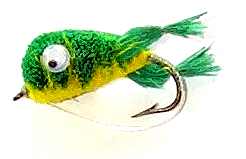Light Green and Yellow Kicking Frog
Bass like to eat frogs and toads that swim near their lair. Frogs have to eat and this means they hunt by swimming which puts them at risk of being eaten. The Light Green and Yellow Kicking Frog bass bug is a good imitation of these amphibians.

DEERHAIR BASS BUG FLY PATTERNS. Hook size 6 - $US each
During the mating process frogs make a lot of noise. They sit around on lilly pads puffing up their throats and loudly telling other frogs they are available for sex, but first they have to fight other frogs for the right to sit on the best located lilly pad. There is a lot of grappling and swimming for position. This normally happens during warm spring evenings. The Bass know a frogs behavior and hang around their haunts, waiting to grab a passing amphibian. Cast a frog bass bug near to a rivers edge and swim it along the bank. A swimming frog has part of its body under the water and this is what I try to mirror. I work plenty of floatant into the bug when it is still dry but leave the underside untreated so it absorbs some of the water.
NORTH AMERICAN BASS FISH
The species of fish collectively known as black bass are the largest members of the Centrachidae family (which also includes bluegill, crappies and sunfish). They include two of the most important sporting fish species in North America: the smallmouth bass and the largemouth bass. (The Sea Bass of the Moronidae group found in Europe, Australia and North America are classified as a different species). Migration and Transplanting Over the last century through migration and transplanting smallmouth and largemouth bass can be found in most parts of North America. They are very adaptive and sometimes can be found in the same stretch of water. As a
generalization it can be said that smallmouth bass spawn most successfully over gravel bottomed water where as largemouth bass prefer mud and silt.
Smallmouth Bass (Micropterus dolomieui) is a hard fighting fish and is the most highly prized black bass. It is a bit larger than the Northern largemouth bass and can reach a maximum of about 12lb (5.4kg). It prefers clear lakes and streams with rock or gravel bottoms
Largemouth Bass (Micropterus Salmoides) has huge upper jaw that extends to behind its eye and has thus given rise to its name. It prefers weedy, mud-bottomed waters. The jaw of the smallmouth bass does not extend beyond its eye. The northern largemouth bass very rarely exceeds 10lb (4.54kg) but the Florida subspecies largemouth bass (Micropterus Salmoides floridanus) can reach 20lb (9.1kg)
Redeye Bass (Micropterus Coosae) in the Southern States of USA has a white tipped orange tail fin. Young redeye bass also have a brick red dorsal and anal fin. It of course has a red eye as you would expect with a name like 'redeye'. It is one of the smaller bass species normally not growing more than 1lb (454g) but they can grow to 8lb (3.6kg).
Suwanne Bass (Micropterus notius) is a small fish that rarely gets bigger than 12oz (340g). It can be found in the Suwannee and Ochlockonee river basins of Florida and Georgia. It has an overall coloration of brown with black marks but the adult male has a distinctive blue belly, breast and cheeks.
Guadalupe Bass (Micropterus treculi) of central Texas has distinctive dark bar markings down its side. It is a small fish and seldom gets larger than 1lb (454g)
Spotted Bass (Micropterus punctulatus) of the Mississippi basin area gets its name from the rows of small dark spots on its belly and flanks. It grows to about 5lb (2.27kg). There are two local subspecies: the Alabama spotted bass (Micropterus punctulatus henshalli) and the Wichita spotted bass (Micropterus punctulatus wichitae).


Bass Bug books

